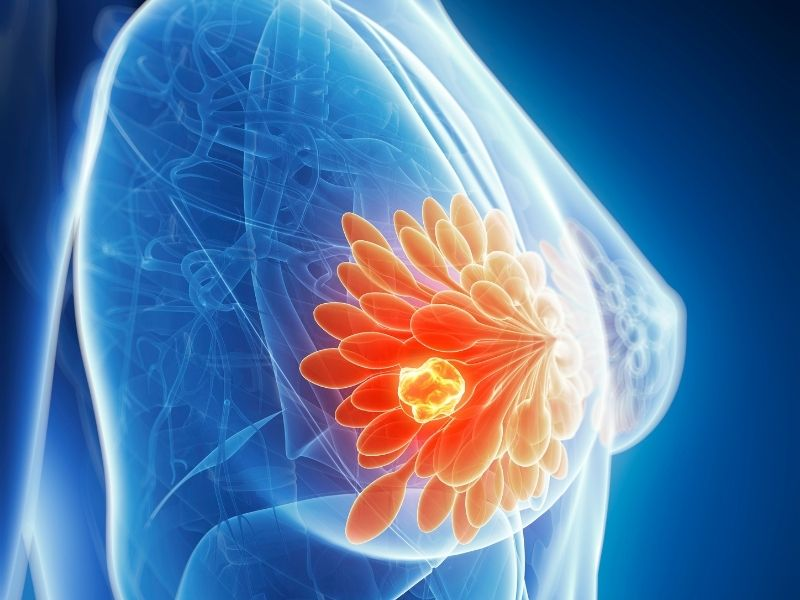Embryology and Histology of the Breast
Breast tissue begins to develop as a pair of structures along the milk line, which extends between the limb buds during the fifth and sixth weeks (7). It then develops from the anterior extensions towards the posterior extensions on the ventral side of the fetus. The caudal part of the milk ducts regresses early during development. During the second trimester, epithelial growth at 15-25 points in the chest area of the fetus penetrates the underlying connective tissue, forming the initial milk ducts. The remaining milk ducts mostly degenerate (8). By the seventh and eighth months, the ductal spaces take the shape of lumens. At the same time, a small indented area appears that will later develop into the nipple. At birth, the areola shows slight thickening compared to the skin. Shortly after birth, the areola becomes easily distinguishable from surrounding tissue due to slight pigmentation. Due to the high estrogen levels from the mother in the newborn, hypertrophy in the glands, prominence of the ductal system, and increased vascularity in the stroma can be observed. These changes usually regress spontaneously during the second to third weeks after birth (9).
Contents
- Embryology and Histology of the Breast
- Breast Anatomy
- Arteries of the Breast
- Nerves of the Breast:
- Lymphatic System of the Breast:
- Axillary Lymph Nodes
- Breast Dysplasias
- Breast Tumors
- Benign Tumors of the Breast
- Malignant Diseases of the Breast
- Non-Infiltrative Breast Malignancies
- Infiltrative Breast Malignancies
- Other Malignant Breast Lesions
- Diagnosis of Breast Diseases
- INTACT BREAST LESION EXCISION SYSTEM (BLES)
Breast Anatomy
In an adult woman, the breast gland is typically located between the superficial and deep layers of the pectoral fascia on the anterior chest wall (10). The breasts are located between the 2nd and 7th ribs. They extend from the edge of the sternum medially to the mid-axillary line laterally.
The upper-outer quadrant of the breast contains more glandular elements compared to other quadrants, making benign and malignant breast tumors more commonly seen in this quadrant. There is an extension of the breast tissue towards the axilla, known as “Spence’s axillary tail.” This structure passes through a space known as Langer’s hole in the deep fascia and extends to the axilla. Any physiological events occurring in the breast also manifest in this axillary tail. The vertical diameter of the breast is on average 10-12 cm, and its maximum thickness in the central region is 5-7 cm. A non-lactating breast weighs between 150-200 grams, while during lactation it can weigh 400-500 grams (10). The dimensions and boundaries of the breast can vary between women and also within the same woman due to pregnancy, breastfeeding, weight gain, weight loss, and aging (Figure 1).
The nipple and areola are located at the center of the breast. This area contains more pigment than the surrounding breast tissue, and its color darkens with increased estrogen levels (11).

There are fibrous projections from the breast tissue that extend outward. These fascial septa, first described by Sir Astley Cooper, are named Cooper's ligaments (12). These ligaments attach to the superficial layer of the superficial fascia and the skin on the surface and to the deep layer of the superficial fascia and pectoral fascia in the deeper part (13). As breast cancer progresses, these fibrous ligaments shorten and retract abnormally, a key finding in breast cancer known as skin retraction. In advanced breasts, the structure consists of acini, ducts, and stromal elements.
Acini are the secretory units of the breast. They are lined with cuboidal or cylindrical epithelium and surrounded by connective tissue, blood, and lymph vessels. The acini come together to form lobules, and these lobules make up lobes. The epithelial parenchyma consists of 15-20 lobes, each opening into a separate duct that leads to the nipple (10,11,13,14). Each lobe contains 20-40 lobules. In other words, each duct drains one lobe and 20-40 lobules. In each lobule, 10 to 100 acini are grouped around a collecting duct. Lobules form the main structural unit of the breast gland and appear larger and more numerous in young women. After menopause, the number of lobules decreases, and each lobule becomes a small unit containing only a few acini. The breast ductal system begins with the joining of acini to form the terminal duct (Figure 2).

The terminal duct has two parts: one within the lobule (intralobular segment) and the other outside the lobule (extralobular segment) (15). Several lobules' terminal ducts merge to form the lactiferous duct. These ducts move towards the nipple, where they enlarge to form the lactiferous sinus, which is lined with multilayered squamous epithelium and opens to the outside at the nipple. In an inactive breast, the lactiferous sinus contains debris from exfoliated epithelial cells, which can block the ductal openings like a plug. The diameter of the lactiferous ducts that drain each lobe is 2-4 mm, and the diameter of the lactiferous sinuses in the subareolar region is 5-8 mm (13).
Arteries of the Breast
The breast is well-supplied with blood and receives nourishment from many sources. The arteries that provide arterial blood supply to the breast and their branches are as follows (10, 14, 16, 17):
- Anterior perforating branches of the internal mammary artery
- Lateral thoracic artery (External mammary artery)
- Pectoral branch of the thoracoacromial artery
- Supreme thoracic artery
- Lateral branches of the posterior intercostal arteries
- Subscapular artery
- Thoracodorsal artery (Figures 3-4)

The veins of the breast follow the distribution of the arteries and accompany them. The distribution of the breast veins, particularly their anastomoses, also determines the pathways for metastatic carcinoma emboli, thus identifying the distant organs where breast cancer most commonly metastasizes (13,16). Accordingly:
- Internal mammary vein → Innominate vein → Superior vena cava (SVC) → Pulmonary capillary network
- Axillary vein → Innominate vein → SVC → Pulmonary capillary network
- Intercostal veins → Azygos veins → SVC → Pulmonary capillary network
- Intercostal veins → Vertebral venous plexuses → Vertebral metastases (18)
According to Batson's theory, retrograde blood flow can easily occur in systems without valves due to low pressure. This allows metastatic elements from breast cancer to retrogradely metastasize to the vertebrae.
Nerves of the Breast:
The sensory innervation of the breast is mainly provided by the 2nd, 3rd, 4th, 5th, and 6th intercostal nerves (13,19). The thoracodorsal nerve, which is typically cut during axillary dissection since it passes through the scapular and central lymph nodes, is not considered a major concern for injury. The nerve that requires attention during dissection is the long thoracic nerve, which innervates the serratus anterior muscle. This nerve must be preserved during axillary dissection, as its severing causes serratus anterior paralysis and the "winged scapula" condition (16).
Lymphatic System of the Breast:
The lymphatic system of the breast can be divided into two subgroups:
- Superficial lymphatics (Skin lymphatics)
- Deep lymphatics (Parenchymal lymphatics)
Superficial Lymphatics of the Breast:
These are the lymphatics of the skin covering the breast. The breast originates from the ectoderm embryologically, and therefore, its lymphatic structure resembles that of other skin appendages. Two main lymphatic networks are found in this region:
- Subepithelial or papillary plexus
- Subdermal lymphatic plexus
The subepithelial plexus has no valves, and lymph flow can occur in any direction. The subdermal plexus has valves and lymph flow is unidirectional. The subareolar plexus (Sappey plexus) is located under the areola. The superficial lymphatics of the breast primarily drain into the axillary lymph nodes via the deep lymphatics.
Deep Lymphatics of the Breast:
The lymphatic vessels of the lactiferous ducts (periductal lymphatics) form a fine network around the breast lobules. Numerous collecting lymphatic trunks emerge from this network. Various views have been proposed about the primary direction of lymphatic spread in the breast. Recent studies using Halsell lymphangiography have shown that the lymphatics within the breast tend to travel centrifugally from the areolar area towards the axilla (20).
The accepted view today is that the lymphatic flow within the breast is centrifugal, from the deep subcutaneous and intramammary lymphatic vessels towards the axillary and internal mammary lymph nodes (Figures 5-6).

Hultbarn and colleagues, after injecting radioactive gold (Au 198) into the breast, determined the rate of radioactivity in the lymph nodes and concluded that approximately 97% of the lymph from the breast drains into the axillary nodes, while the remaining 3% drains into the internal mammary chain (21).
Axillary Lymph Nodes
Axillary lymph nodes form the most important drainage area for lymph flow from the breast. Although the axillary lymphatic system forms a whole, for ease of description and to assess the degree of spread of breast cancer, the lymph nodes can be divided into six groups for examination (22). The number of axillary lymph nodes usually ranges between 20 to 40 (10).
- External mammary nodes: Found under the outer edge of the pectoralis major muscle along with the lateral thoracic vessels. Efferent lymphatic vessels from these nodes mostly drain to the central lymph nodes and partially to the subclavicular lymph nodes.
- Scapular nodes: These nodes extend from the point where the subscapular vein exits the axillary trunk to where it joins the latissimus dorsi muscle, located in the lateral chest wall. The intercostobrachial nerve (2nd intercostal nerve) and thoracodorsal nerve pass through these scapular nodes. During axillary dissection, it is unnecessary to attempt to separate these nerves from nearby lymph nodes that may contain metastases, as severing these nerves typically does not result in significant disability.
- Central nodes: These are relatively large lymph nodes located in the center of the axilla and are often the most easily palpable. As drainage from other groups of lymph nodes often goes to the central nodes, metastases are also most often found here.
- Interpectoral (Rotter) nodes: This group contains 1-4 lymph nodes located between the pectoralis major and minor muscles.
- Axillary vein nodes: These nodes are located along the lateral side of the axillary vein or inside or behind it. During axillary dissection, it is unnecessary to remove the fascial sheath of the axillary vein.
- Subclavicular nodes: This group of lymph nodes is located at the very top of the axilla, just inside the point where the thoracoacromial vein exits. According to Haagensen, metastasis in the subclavicular lymph nodes indicates that the case is “inoperable” and that radical surgery is not possible (16).
The lymphatic vessels originating from the subclavicular lymph nodes are interconnected, forming a plexus. From these lymphatic plexuses, one or more large lymphatic trunks (Subclavicular lymphatic trunks) emerge.
Internal Mammary Lymphatic Pathway: The internal mammary lymphatic pathway originates from the prepericardial lymph nodes on the anterior surface of the diaphragm (16).
The lymph fluid reaching the prepericardial lymph nodes comes from the following areas through collecting lymphatics:
- From the upper-front part of the liver through the falciparum ligament
- From the front part of the diaphragm
- From the upper part of the rectus abdominis muscle
- From the rectus sheath
- From the lower-inner quadrant of the breast gland
The lymphatic trunks from the prepericardial lymph nodes travel upward, passing along both sides of the sternum. The main lymphatics that drain the breast into the internal mammary lymphatic pathways arise from the deep surface of the breast and the internal part of the breast gland. These vessels travel along the pectoral fascia or penetrate it and enter the pectoralis major muscle. They travel medially along the perforating branches and end in the internal mammary lymph nodes at the inner ends of the intercostal spaces.
Breast Dysplasias
Breast dysplasias constitute the largest portion of complaints related to the breast in women. This group includes macro-cysts, micro-cysts, apocrine changes, adenosis, fibrosis, and ductal hyperplasia. These lesions are seen in up to 90% of women, including those without any breast complaints, suggesting that this is not a disease.
Breast dysplasias are most commonly seen between the ages of 30-50. They are rare after menopause. If estrogen therapy is given post-menopause, the frequency of dysplasia increases. It is thought that the cause of dysplasia may be related to ovarian activity. The most widely accepted view today is that it results from an increase in estrogen, particularly estradiol, or a decrease in progesterone levels, disrupting the balance between estrogen and progesterone (23).
Clinically, breast dysplasia presents as pain, nodularity, tissue density, or a mass in the breast.
Mastalgia: A significant portion of women experience fullness, enlargement, tenderness, and varying degrees of pain in the breast close to menstruation. These symptoms disappear within a few days after the onset of menstruation, and this is considered a physiological phenomenon. However, some women experience more severe pain or have a much longer painful period. This condition, called cyclic mastalgia, can significantly affect a woman’s daily life and may cause her to worry about a severe illness. Cyclic mastalgia disappears after menopause.
Nodularity: This symptom appears shortly after menstruation and reappears near the next menstruation period. Some women have persistent nodularity, although it does not show pathological characteristics.
Tissue Density: It is more noticeable around the time of menstruation. On the 8-10th day of menstruation, the breast tissue appears relatively normal, making it easier to detect without distinct masses.
Macro-cysts: These occur in 7% of women. The incidence increases with age, peaking between the ages of 40-50. They are rare in post-menopausal women. Macro-cysts can easily be diagnosed with mammography and ultrasound (Figure 7).

Other forms of breast dysplasias that can present as masses include sclerosing adenosis, ductal, and lobular hyperplasia (23).
Breast Tumors
Lesions of the breast are usually palpable. Sometimes they present as painful nodules or masses. While most of these are benign, it should not be overlooked that breast cancer is one of the leading causes of cancer-related deaths in women (24).
Benign Tumors of the Breast
Fibroadenomas: These are benign tumors that exhibit both stromal and epithelial proliferation. They originate from the breast lobules. Recent thoughts suggest these are more of an aberration in normal lobular development than true tumors. They grow during pregnancy and lactation, shrinking after weaning and menopause. Hormone therapy, especially estrogen, can cause an increase in their size. Fibroadenomas are commonly seen shortly after puberty and peak during the reproductive years. The incidence decreases after menopause (Figure 8).

Phyllodes Tumors: These tumors have a broad spectrum ranging from benign and locally aggressive to metastatic lesions. They are most commonly seen in premenopausal women.
Lipoma: These are composed of mature fat cells. They are smooth and well-circumscribed soft masses. Small lipomas have normal mammography findings, while large lipomas show compression of surrounding breast tissue and a radiolucent area on mammography.
Hamartoma: These are rare benign encapsulated tumors formed from an abnormal mixture of normal breast tissues (7).
Malignant Diseases of the Breast
Breast cancer is the most common cancer seen in women and is known to be the leading cause of cancer-related deaths in societies, particularly in developed Western countries. The likelihood of developing breast cancer in a woman at the age of fifty is approximately 10% (25) (Figure 9).

Certain hereditary syndromes increase the likelihood of breast cancer. Some of these syndromes include Hereditary breast-ovarian cancer syndrome, region-specific hereditary breast cancer, Li-Fraumeni syndrome, Cowden syndrome, and Muir syndrome (26,27).
Breast cancer is quite rare before the age of twenty. After the age of twenty, the incidence gradually increases and plateaus between the ages of 45-55. After the age of 55, the incidence rapidly rises (27).
Women with a family history of breast cancer, especially those with a mother or sister who has had breast cancer, are at higher risk. In these individuals, the disease typically occurs 10-12 years earlier. Women with breast cancer also have a significantly increased risk of developing cancer in the contralateral breast. In families with a history of bilateral breast cancer, the incidence of bilateral breast cancer is higher. In particular, having bilateral breast cancer in the family increases the risk of early-onset breast cancer. Women with a history of cellular atypia, atypical ductal hyperplasia, lobular neoplasia, or juvenile papillomatosis in previous breast biopsies have an increased risk of developing breast cancer (27,28,29). Women with blood group “O” have been observed to have benign breast diseases, ovarian cysts, and breast cancer at a younger age.
Many studies have shown that delayed menarche reduces the risk of breast cancer by 1/3-1/2. Menarche before the age of twelve increases the incidence by twofold. Early menarche is a risk factor for the development of breast cancer (27,30,31). Women who have never given birth show an increased incidence. Women who have their first pregnancy after the age of thirty are at a higher risk of developing breast cancer compared to those who have their first pregnancy after the age of eighteen. Women who experience menopause later also show an increased incidence (27, 32).
The effect of postmenopausal hormone therapy on the incidence of breast cancer is still debated. Some studies have found a 25% increase in breast tissue density on mammography in women receiving postmenopausal hormone therapy (33,34). Hormone therapy induces breast pain in 36% of cases, and mammographic changes are observed in 17-32% of cases (34,35). There are also significant geographic differences in the incidence of breast cancer. For example, in the Netherlands, the incidence is 24.19 per 100,000, in the United States, it is 21.38, and in Japanese women, it is 3.76 per 100,000. Environmental factors play a role, as Japanese women who migrate to the United States show an increased incidence.
Exposure to pesticides also increases the risk of breast cancer (36). The intake of fat and cholesterol in the diet is very important. There is a direct correlation between the amount of fat consumed per capita and breast cancer. This relationship is stronger in postmenopausal women than in premenopausal women. Obesity and chronic alcohol use in postmenopausal women also increase the risk (28, 36).
Radiation is also a risk factor for breast cancer. People exposed to ionizing radiation after the atomic bomb, those who underwent radiation therapy due to postpartum mastitis, patients who were followed for tuberculosis using fluoroscopy, and animal models exposed to radiation have shown an increased risk of breast cancer (27, 37).
Recent genetic studies have highlighted the importance of genetic factors in the etiology of premenopausal breast cancer. The risk of breast cancer is significantly increased in individuals carrying mutated BRCA1 and BRCA2 genes. These genes are located on chromosomes 17 and 13, and those who carry them have an 85% chance of developing breast cancer. BRCA1 and BRCA2 genes have been found to be positive in 5% of all breast cancer cases (27, 28).
The recessive Retinoblastoma gene located on chromosome 13 is a tumor suppressor gene, and its loss of heterogeneity on this chromosome leads to premenopausal breast cancer. As with colon cancer, the P53 tumor suppressor gene on chromosome 17 is also crucial in the development of breast cancer, and its loss is associated with breast cancer. Additionally, the erb-B2 oncogene has been shown to provide important prognostic information for breast and ovarian cancer (38,39,40).
The major risk factors for breast cancer include family history, previous breast cancer, genetic predisposition, carrying BRCA1 and BRCA2 genes, and previous benign breast diseases (27,29). Among benign breast diseases, fibrocystic disease, solid or papillary moderate hyperplasias, fibrovacular nodular papillomas, atypical ductal or lobular hyperplasias, and neoplasias (lobular carcinoma in situ) are commonly associated with breast cancer (27,40,41).
Minor risk factors include early menarche, late menopause, postmenopausal obesity, alcohol consumption, low-dose radiation, diabetes mellitus, advanced age, late first pregnancy, exposure to pesticides, and long-term oral contraceptive use (27,30,35).
The histopathology of breast cancers shows that 90% of them originate from ductal epithelium, and 10% from lobular epithelium (26). The classic mammographic appearance of breast carcinomas is an ill-defined, irregular mass. The density of the lesion is either higher or equal to that of the surrounding breast tissue. Fine linear spiculations are seen at the edges of the lesion. Mammographically, a mass with spiculations is a typical sign of infiltrative breast cancer (41).
Breast cancer is classified based on clinical or histopathological criteria.
Non-Infiltrative Breast Malignancies
- Ductal carcinoma in situ
- Lobular carcinoma in situ
Infiltrative Breast Malignancies
- Infiltrative Ductal Carcinoma
- Infiltrative Lobular Carcinoma
- Medullary Carcinoma
- Mucinous Carcinoma
- Tubular Carcinoma
- Adenoid Cystic Carcinoma
- Infiltrative Papillary Carcinoma
- Paget's Disease
- Inflammatory Breast Cancer
Other Malignant Breast Lesions
- Lymphomas and Leukemias
- Metastatic Cancers
- Sarcomas
Diagnosis of Breast Diseases
- History
- Physical Examination
- Testing
- Cytological Study
- Microbiological Study
- Ultrasonography
- Mammography
- CT (Pituitary)
For women over 30 with palpable masses, the first imaging method should be mammography, whereas for those under 30, ultrasound is preferred (Figure 10). This is due to the reduced diagnostic sensitivity of mammography in younger individuals because of the dense breast pattern.



FINE NEEDLE ASPIRATION BIOPSY (FNAB): This method is used to obtain microscopic tissue samples from suspicious structures in any part of the body, especially superficial tissues like the breast and thyroid, using a fine needle under ultrasound guidance or palpation. It is preferred for its quick results, low cost, and ease of use (Figure 11).
It is suitable for use only in cystic lesions and intraductal solid lesions. Its diagnostic ability is far less than core biopsy in solid masses, as FNAB is a cell biopsy rather than a tissue biopsy. Even when performed under ultrasound guidance, sufficient tissue may not be collected for accurate diagnosis in many cases.
In large cysts, ultrasound-guided aspiration is a useful method for draining them, especially when the cyst is palpable and causing discomfort (such as tension or pain). During this "cyst aspiration" procedure, the needle tip should be monitored under ultrasound to ensure complete drainage of the cyst. If performed without ultrasound guidance, it is possible to partially drain the cyst, leading to the mistaken assumption that it is completely drained.
The risks include:
- A cyst that is not fully drained may grow again, causing the patient's complaints to return.
- Non-ultrasound-guided aspirations can be traumatic; the cyst wall may be damaged, leading to bleeding or inflammatory cell accumulation inside the cyst. As a result, the simple cyst may change in appearance, making subsequent radiological assessments more difficult and increasing the likelihood of misdiagnosis. Furthermore, the increased fluid density within the cyst can make subsequent aspiration more difficult. Therefore, aspiration should always be done under ultrasound guidance, even for palpable cysts.
CORE BIOPSY - TRU-CUT NEEDLE BIOPSY (TCNB): Similar to FNAB, but with a thicker needle, core biopsy allows for the collection of tissue samples from suspicious areas for detailed examination. It provides more detailed diagnostic information than FNAB. This method uses long cylindrical tissue samples, most commonly with a tru-cut needle. The specificity of this method is reported as 98%, and its sensitivity is 100%. FNAB can only provide cytological examination, whereas this method allows for histological assessment and the evaluation of hormone receptors (43).
The procedure involves using thick, cutting-edge needles to extract small tissue samples from various parts of the suspicious lesion. The tissue samples are typically around 2 cm long and 1 mm thick. With these samples, the type of cancer, its grade (level of cellular activity), and information about receptors that influence treatment decisions can be determined. The accuracy of these results is generally comparable to that of surgical biopsies.
Core biopsy can reduce the need for surgical interventions, as it allows for diagnostic and treatment decisions (two steps) to be made from the same biopsy, rather than requiring two separate procedures. As a result, the likelihood of surgical complications is reduced, and patients can return to their daily lives faster and more comfortably.
In core biopsies, the entire lesion is not removed. Only the most representative samples are taken. Therefore, if the lesion's radiological features are highly suspicious, a surgical biopsy may still be needed to confirm the diagnosis.
Like FNAB, ultrasound guidance is preferred for core biopsies, as different regions of the lesion may have different characteristics. Taking tissue samples from various regions under ultrasound guidance ensures that the biopsy represents the disease more accurately. The first automated tru-cut breast biopsy method under ultrasound guidance was described by Parker in 1993 (43).
Even in palpable lesions, core biopsy should be done under ultrasound guidance to ensure the correct area is sampled. Automatic core biopsy with tru-cut needles has been shown to have excellent accuracy, particularly in diagnosing ductal carcinoma in situ (DCIS) (44,45).
VACUUM-ASSISTED BIOPSY (VAB): This method is similar to core biopsy but involves using a vacuum device to remove tissue samples from a lesion. It offers a significant improvement in tissue capture compared to core biopsy, leading to larger, more reliable samples. This technique is often referred to by its device name, Mammotome. During the procedure, the biopsy probe is advanced to the lesion, and the vacuum draws the tissue into the probe. The cutting section of the needle advances through the lesion to collect a sample. Bleeding is aspirated through the vacuum section, and after tissue collection, the needle is rotated slightly to collect more samples. This process can be repeated multiple times in a single session (46).
VAB has several advantages over core biopsy, including the ability to collect more tissue with fewer punctures, the larger and thicker tissue samples, and the reduction in bleeding thanks to the vacuum. These advantages make it useful for diagnosing certain pathologies like DCIS and lobular carcinoma in situ (LCIS). VAB offers higher diagnostic accuracy compared to other biopsy techniques, but it is also more expensive (47,48,49).

OPEN BIOPSY: If FNAB or core biopsy cannot be performed, a small surgical procedure can be done to remove part or all of the suspicious area for examination. This procedure allows for a definitive diagnosis (Figures 12,13).


WIRE MARKING: This is a technique used to remove breast masses that are visible on mammography but not on ultrasound or palpable. Using special tools and calculation methods, a biopsy wire is placed into the suspicious area under mammographic guidance, and the mass is removed with the wire (which is also used to guide the removal process). This method requires surgery after the marking is done.
GALACTOGRAPHY: This procedure involves injecting a visible substance into the milk ducts of the breast, making them visible on an X-ray and allowing for detailed imaging of any abnormalities in the ducts.
ULTRASONOGRAPHY (USG): This technique uses high-frequency sound waves to visualize various parts of the body. Special ultrasound probes are used for superficial tissues such as the breast and thyroid. Since there is no known harm from ultrasound, it is the preferred imaging method for pregnant women and infants.
MAMMOGRAPHY: Mammography is an imaging technique that uses X-rays to visualize breast tissue and is essential for women over the age of 35. Even if a woman has no symptoms, mammography should be done at regular intervals as prescribed by her doctor. Contrary to popular belief, mammography does not harm breast tissue. However, in very young patients, dense breast tissue can make it more difficult to obtain high-quality images.
INTACT BREAST LESION EXCISION SYSTEM (BLES)
This system is designed to completely remove detected masses in the breast. BLES stands for Breast Lesion Excision System.





